
A clipper was a type of mid-19th-century merchant sailing vessel, designed for speed. Clippers were generally narrow for their length, small by later 19th century standards, could carry limited bulk freight, and had a large total sail area. "Clipper" does not refer to a specific sailplan; clippers may be schooners, brigs, brigantines, etc., as well as full-rigged ships. Clippers were mostly constructed in British and American shipyards, though France, Brazil, the Netherlands and other nations also produced some. Clippers sailed all over the world, primarily on the trade routes between the United Kingdom and China, in transatlantic trade, and on the New York-to-San Francisco route around Cape Horn during the California Gold Rush. Dutch clippers were built beginning in the 1850s for the tea trade and passenger service to Java.

Flying Cloud was a clipper ship that set the world's sailing record for the fastest passage between New York and San Francisco, 89 days 8 hours. The ship held this record for over 130 years, from 1854 to 1989.
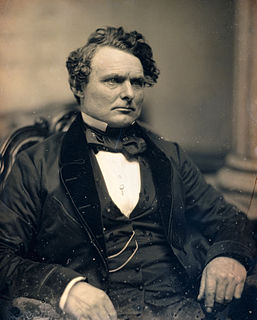
Donald McKay was a Canadian-born American designer and builder of sailing ships, famed for his record-setting clippers.

Stag Hound was launched on December 7, 1850 in East Boston, Massachusetts. Designed by shipbuilder Donald McKay for the California trade, she was briefly the largest merchant ship in the world. She was in active service from 1851 until her total loss in 1861.

Northern Light was an American clipper ship. In 1853 she sailed from San Francisco, California to Boston, Massachusetts via Cape Horn with Captain Freeman Hatch at the helm in a record-setting 76 days, 6 hours. The record still stands for a single hull vessel. In 1993 the record was soundly broken by a multi-hull sailing vessel Great American II with no cargo. Sailing around Cape Horn is widely regarded as one of the most challenging routes in yachting, due to extreme weather, strong currents, and a historical reputation for mountainous seas and frequent severe storms.
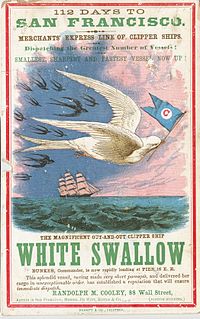
White Swallow was an extreme clipper built in Boston in 1853 for the California trade.
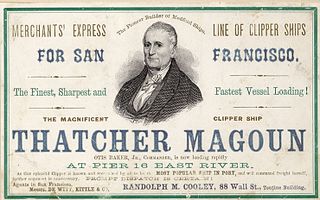
The Thatcher Magoun, an extreme clipper launched in 1855, was named after Medford's great shipbuilder, Thatcher Magoun, who died the year that she was launched.
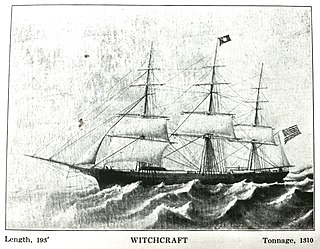
Witchcraft was a clipper built in 1850 for the California and China trade. She made record passages from Rio de Janeiro to San Francisco, and from San Francisco to Callao, Peru.

Sea Serpent was an 1850 extreme clipper that sailed in the San Francisco trade, the China trade, and the transatlantic lumber trade. She was one of the longest lived clippers, with a service life of 36 years and 5 months.
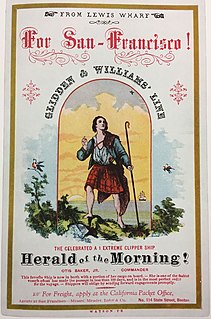
Herald of the Morning was one of the few clipper ships with a passage to San Francisco in less than 100 days.
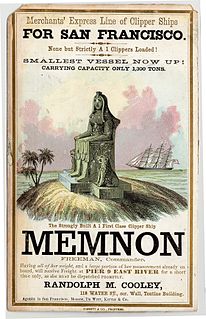
The Memnon was the first clipper ship to arrive in San Francisco after the Gold Rush, and the only clipper to arrive in San Francisco before 1850. Built in 1848, she made record passages to San Francisco and to China, and sailed in the first clipper race around Cape Horn.
Antelope was a medium clipper built in 1851 in Medford, near Boston, Massachusetts. She sailed in the San Francisco, China, and Far East trades, and was known for her fine finish work and for her crew's escape from pirates. She is often called Antelope of Boston to distinguish her from an extreme clipper launched in 1852, Antelope of New York.
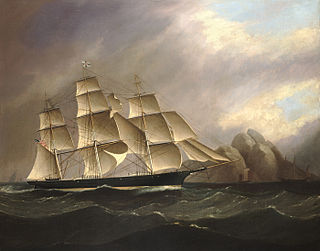
Ocean Telegraph was an American clipper ship. Built in 1854 for the run between New York and San Francisco, she was sold to a British firm in 1863 and renamed Light Brigade. For the next 12 years she was used predominantly to transport cargo and immigrants between London and Australia and New Zealand.
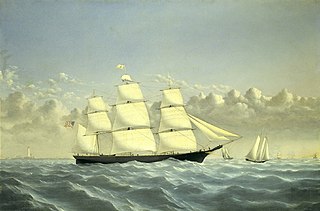
Golden West was an 1852 extreme clipper built by Paul Curtis. The ship had a very active career in the California trade, the guano trade, the coolie trade, the Far East, and Australia. She made a record passage between Japan and San Francisco in 1856.

Golden Fleece was an 1855 medium clipper in the California trade, built by Paul Curtis. She was known for arriving with cargoes in good condition, for making passages in consistently good time, and for catching fire with a load of ice.

Witch of the Wave was a long-lived extreme clipper in the California trade, with a sailing life of over 34 years. In 1851, she sailed from Calcutta to Boston in 81 days, setting a record. It was renamed the Electra in 1871.
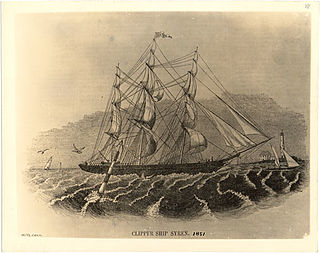
Syren was the longest lived of all the clipper ships, with a sailing life of 68 years 7 months. She sailed in the San Francisco trade, in the Far East, and transported whaling products from Hawaii and the Arctic to New Bedford.

Starlight was a medium clipper built in 1854 in South Boston, Massachusetts that made nine passages from New York City or Boston to San Francisco. The ship was known in its day for "making passages faster than average". Starlight is better remembered today as the subject of two paintings by artist Fitz Hugh Lane. Starlight was described as having "spacious staterooms" and a figurehead resembling "the representation of an antediluvian bird of Paradise spliced into a mermaid".
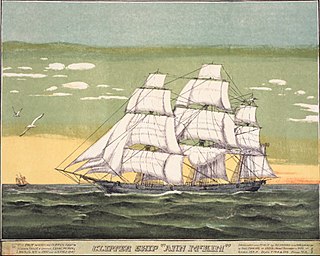
Ann McKim was one of the first true clipper ships. The opening of new Treaty ports in the East in the early 1840s eased an access of the US merchants to China, which demanded the ships that could move cargo faster than then-traditional slow-moving, high-capacity merchant ships. The Ann McKim was one of the ships that had answered the demand in the early years and sailed between New York and China in 1840–1842, until newer and faster cargo-carriers, such as the nearly 600-ton clipper Houqua, the 598-ton China packet Helena, Witch of theWave, and Rainbow, with the last two built expressly to outperform the Ann McKim started dominating the shipping world of the US-China trade and the Ann McKim was shifted back to the South American trade routes.

Hurricane was a large extreme clipper of 1608 tons burthen built in Hoboken, New Jersey, United States in 1851. Reputedly the most extreme clipper ever built, Hurricane proved a very fast vessel, reportedly capable of speeds of up to 18 knots (33 km/h) in ideal conditions, and establishing a number of record passages in the early years of her career.




















